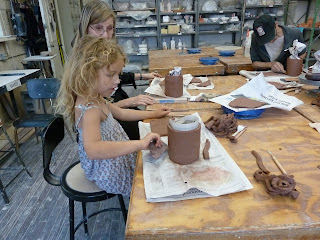This is a reprint of the artbusnyc blog we wrote in 2011 to celebrate the 4th of July and our Declaration of Independence from English rule forever. Today is the 4th of July 2012.
Today is America's birthday. I'm not sure how you celebrate a country's birthday. Do you have a birthday party? Do you bake a birthday cake? Do you make t-shirts? Do you light fireworks? I decided I would celebrate America's birthday with a blog called "Happy Birthday America."
More than 200 years ago, there were 13 colonies in America.The colonists were mostly farmers. They were ruled by Great Britain and King George III. King George made life hard for the colonies by demanding high taxes for things the colonists needed, like tea.
The colonists decided they wanted freedom from Great Britain. They wanted to make their own rules and create their own government. They formed the Continental Congress.
They asked Thomas Jefferson, a young lawyer, to write a declaration of America's independence from King George and Great Britain.
Two important statesmen, Benjamin Franklin
and John Adams helped revise the declaration.
It became known as the Declaration of Independence. It promised the people "Life, Liberty, and the Pursuit of Happiness." After many revisions, the Declaration was sent to Congress where the fifty-six members signed it.
John Hancock, the leader of the Congress, signed it so flamboyantly that his signature has become an icon, and we say "Put your John Hancock on this document.
George Washington asked Betsy Ross to celebrate the new nation and sew the first flag.
I'm sure someone baked a cake.
On July 4th, 1776, the Declaration of Independence was adopted by the Continental Congress, and America became a new country. Yea!!
Now we celebrate every 4th of July. Artists celebrate with art. like Jasper Johns who painted the "Three Flags." It hangs at the Museum of Modern Art in New York.
The Declaration of Independence described our dream of how we wanted our country to be. We invented a system of government that would give all people what they needed. Benjamin Franklin made his ideas clear when he said,"every man is a property owner, has a vote in Public Affairs, lives in a tidy, warm House, has plenty go good Food and Fuel. with clothes from Head to Foot.
Every the 4th of July, we celebrate America's birthday and our Declaration of Independence, with fireworks. The people of our nation are constantly working and voting, to make the great ideas of our dream, become more of a reality.




















































